Page 70 of 385
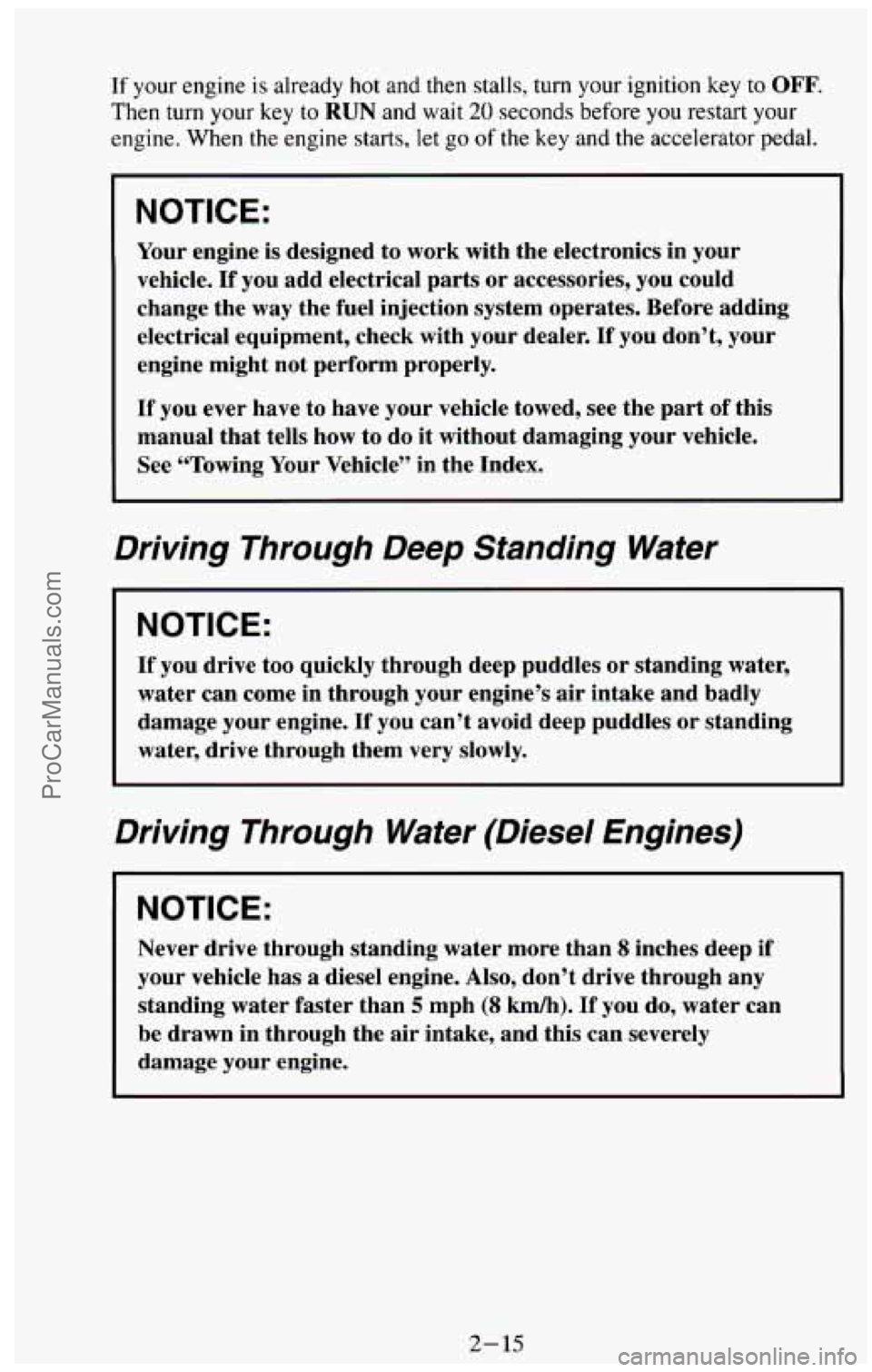
If your engine is already hot and then stalls, turn your ignition key to OFF.
Then turn your key to RUN and wait 20 seconds before you restart your
engine. When the engine starts, let
go of the key and the accelerator pedal.
NOTICE:
Your engine is designed to work with the electronics in your
vehicle. If you add electrical parts or accessories, you could
change the way the fuel injection system operates. Before adding
electrical equipment, check with your dealer.
If you don’t, your
engine might not perform properly.
If you ever have to have your vehicle towed, see the part of this
manual that tells how to do it without damaging your vehicle.
See “Towing Your Vehicle” in the Index.
Driving Through Deep Standing Water
NOTICE:
If you drive too quickly through deep puddles or standing water,
water can come in through your engine’s air intake and badly
damage your engine.
If you can’t avoid deep puddles or standing
water, drive through them very slowly.
Driving Through Water (Diesel Engines)
NOTICE:
Never drive through standing water more than 8 inches deep if
your vehicle has a diesel engine.
Also, don’t drive through any
standing water faster than
5 mph (8 km/h). If you do, water can
be drawn in through the air intake, and this can severely
damage your engine.
2-15
ProCarManuals.com
Page 74 of 385
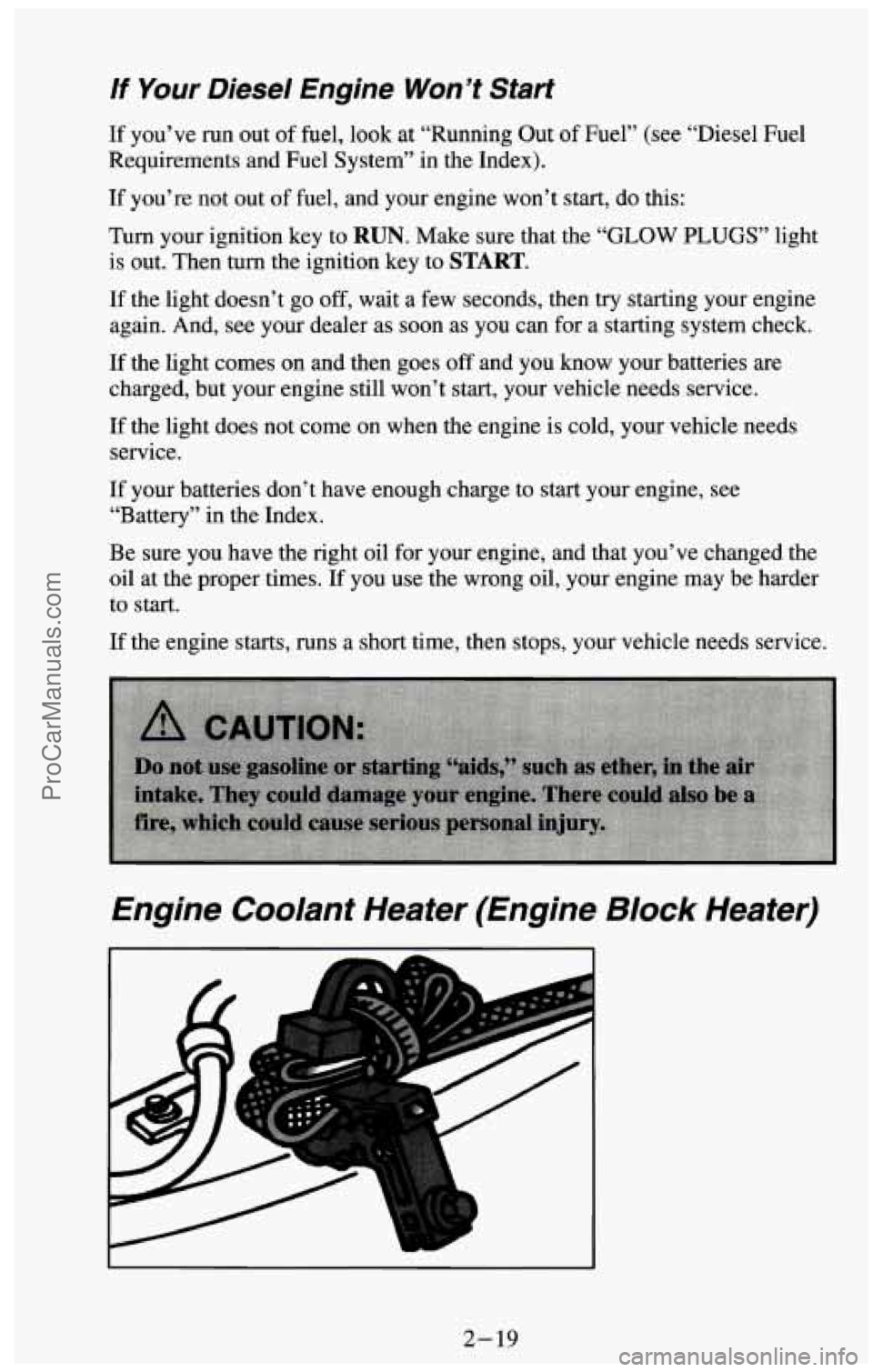
If Your Diesel Engine Won’t Start
If you’ve run out of fuel, look at “Running Out of Fuel” (see “Diesel Fuel
Requirements and Fuel System” in the Index).
If you’re not out of fuel, and your engine won’t start, do this:
Turn your ignition key to RUN. Make sure that the “GLOW PLUGS” light
is out. Then turn the ignition key to
START.
If the light doesn’t go off, wait a few seconds, then try starting your engine
again. And, see your dealer as soon as you can for a starting system check.
If the light comes on and then goes off and you know your batteries are
charged, but your engine still won’t start, your vehicle needs service.
If the light does not come
on when the engine is cold, your vehicle needs
service.
If your batteries don’t have enough charge to start your engine, see
“Battery” in the Index.
Be sure you have the right oil for your engine, and that you’ve changed the
oil at the proper times. If you use the wrong oil, your engine may be harder
to start.
If the engine starts, runs a short time, then stops, your vehicle needs service.
Engine Coolant Heater (Engine Block Heater)
2- 19
ProCarManuals.com
Page 121 of 385
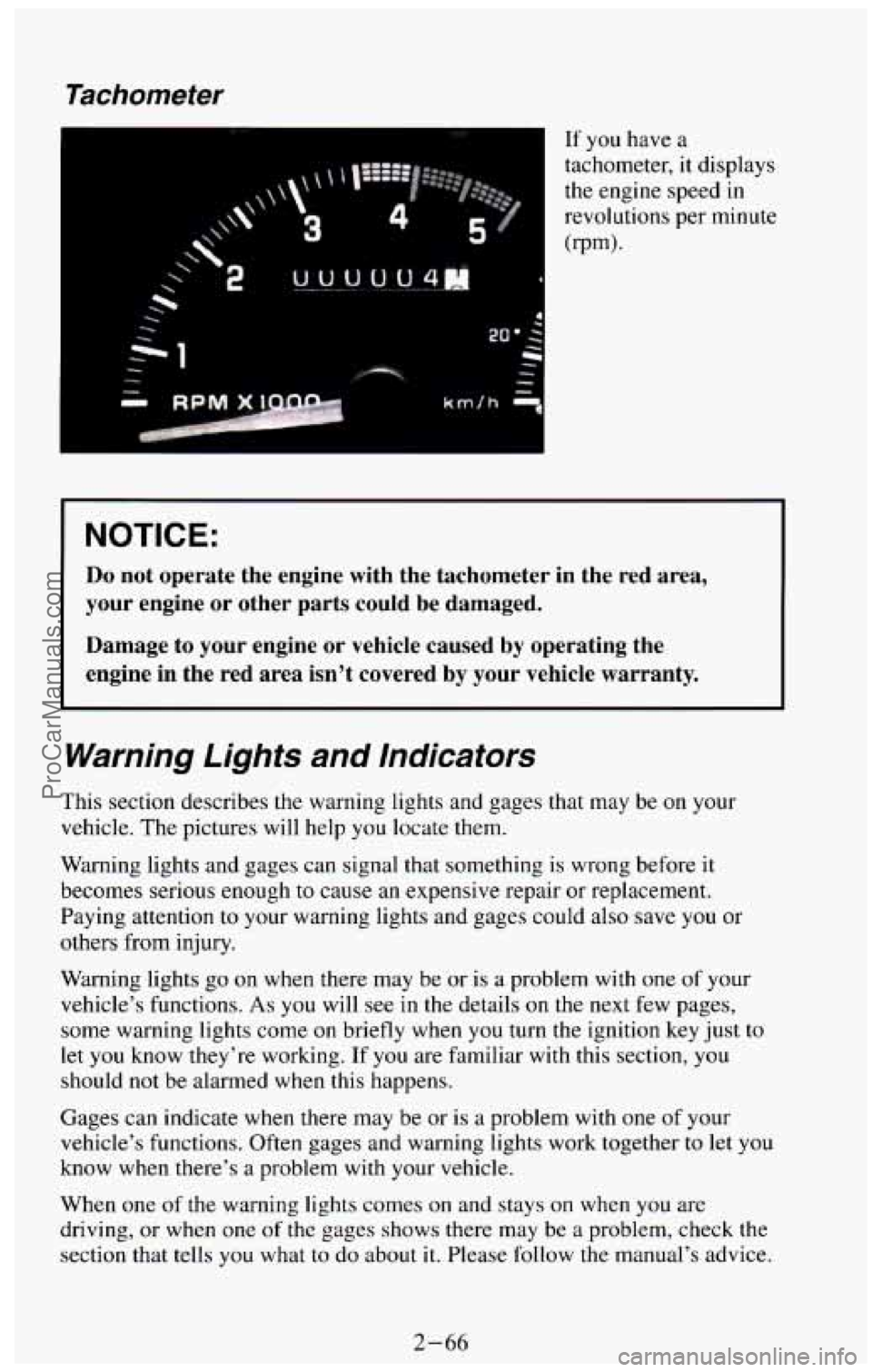
Tachometer
4
If you have a
tachometer,
it displays
the engine speed in
revolutions per minute
(rpm).
I NOTICE:
Do not operate the engine with the tachometer in the red area,
your engine
or other parts could be damaged.
Damage to your engine
or vehicle caused by operating the
engine in the red area isn't covered by your vehicle warranty.\
Warning Lights andl Indicators
This section describes the warning lights and gages that may be on your
vehicle. The pictures will help you locate them.
Warning lights and gages can signal that something
is wrong before it
becomes serious enough to cause
an expensive repair or replacement.
Paying attention to your warning lights and gages could also save you or
others from injury.
Warning lights
go on when there may be or is a problem with one of your
vehicle's functions.
As you will see in the details on the next few pages,
some warning lights come on briefly when you turn the ignition key
just to
let you know they're working. If you are familiar with this section, you
should not be alarmed when this happens.
Gages can indicate when there may be or is a problem with one of your
vehicle's functions. Often gages and warning lights work together
to let you
know when there's
a problem with your vehicle.
When one
of the warning lights comes on and stays on when you are
driving,
or when one of the gages shows there may be a problem, check the
section that tells you what to
do about it. Please follow the manual's advice.
2-66
ProCarManuals.com
Page 124 of 385
Service Throttle Soon Light
The orange Service
Throttle Soon light,
if
you have one, is
located near the
middle left edge
of the
instrument cluster
On diesel engines, a computer monitors the operation of the electronic
accelerator. This light should come
on when the ignition is on but the engine
is not running, as a check to show you its working. If it does not come on at
all, have it fixed right away.
If the light stays on after the engine starts or
comes on while you are driving, the computer is indicating that you have a
problem. You should take your vehicle in for service soon.
Glow Plugs Light
The orange Glow
Plugs light, if you
have
one, is located
near the upper right
corner
of the
instrument cluster.
If you have a diesel engine, it has a special starting system. An instrument
panel Glow Plugs light tells you when
the engine is ready to be started. For
more details, see “Starting Your Diesel Engine” in the Index.
2-69
ProCarManuals.com
Page 125 of 385
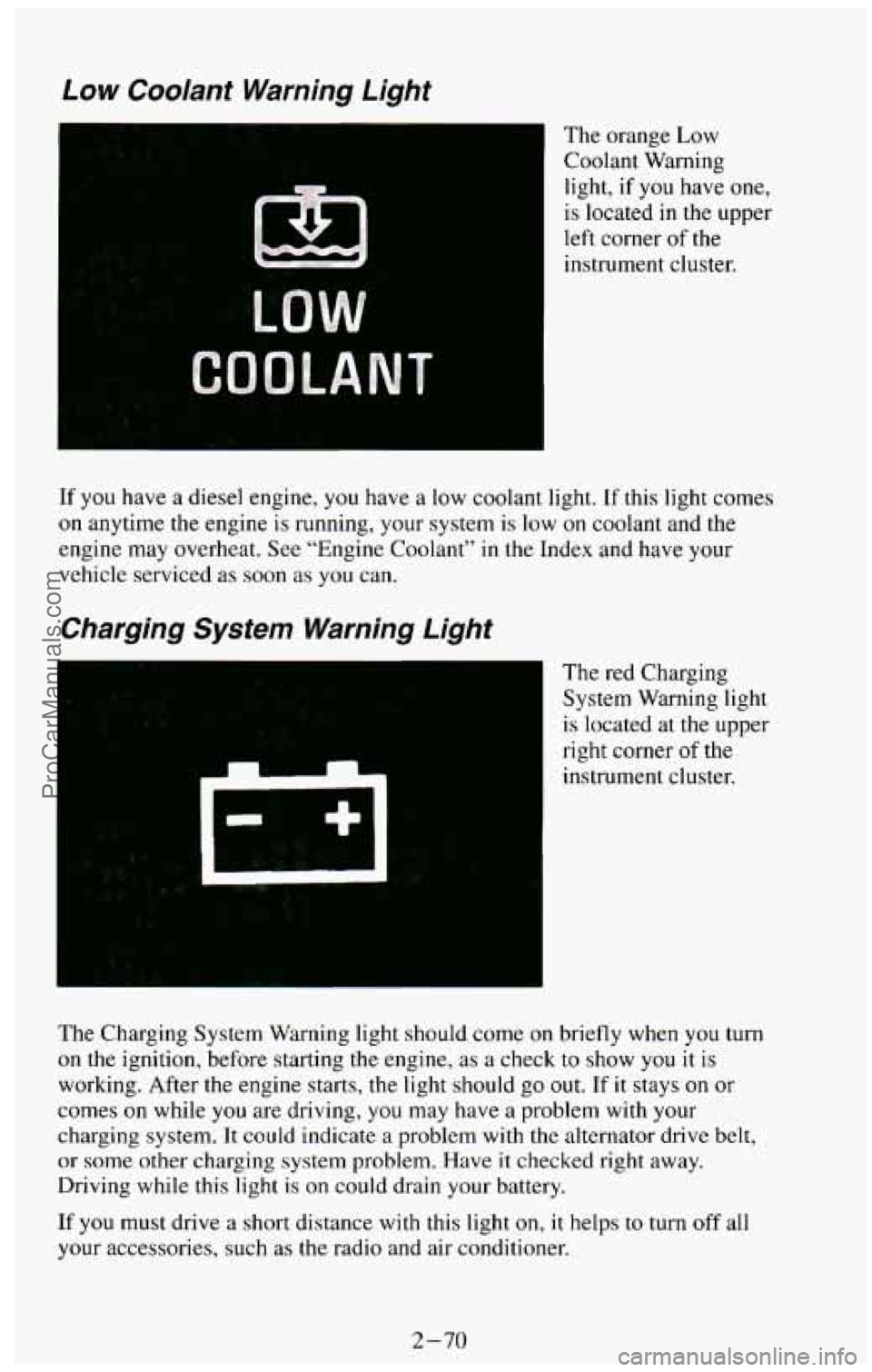
Low Coolant Warning Light
The orange Low
Coolant Warning
light, if
you have one,
is located in the upper
left corner of the
instrument cluster.
If
you have a diesel engine, you have a low coolant light. If this light comes
on anytime the engine is running, your system is low on coolant and the
engine may overheat. See “Engine Coolant”
in the Index and have your
vehicle serviced
as soon as you can.
Charging System Warning Light
The red Charging
System Warning light
is located at the upper
right corner of the
instrument cluster.
The Charging System Warning light should come on briefly when you turn
on the ignition, before starting the engine, as a check to show you it is
working. After the engine starts, the light should go out. If it stays on or
comes
on while you are driving, you may have a problem with your
charging system. It could indicate a problem with the alternator drive belt,
or
some other charging system problem. Have it checked right away.
Driving while this light is on could drain your battery.
If
you must drive a short distance with this light on, it helps to turn off all
your accessories, such
as the radio and air conditioner.
2-70
ProCarManuals.com
Page 126 of 385
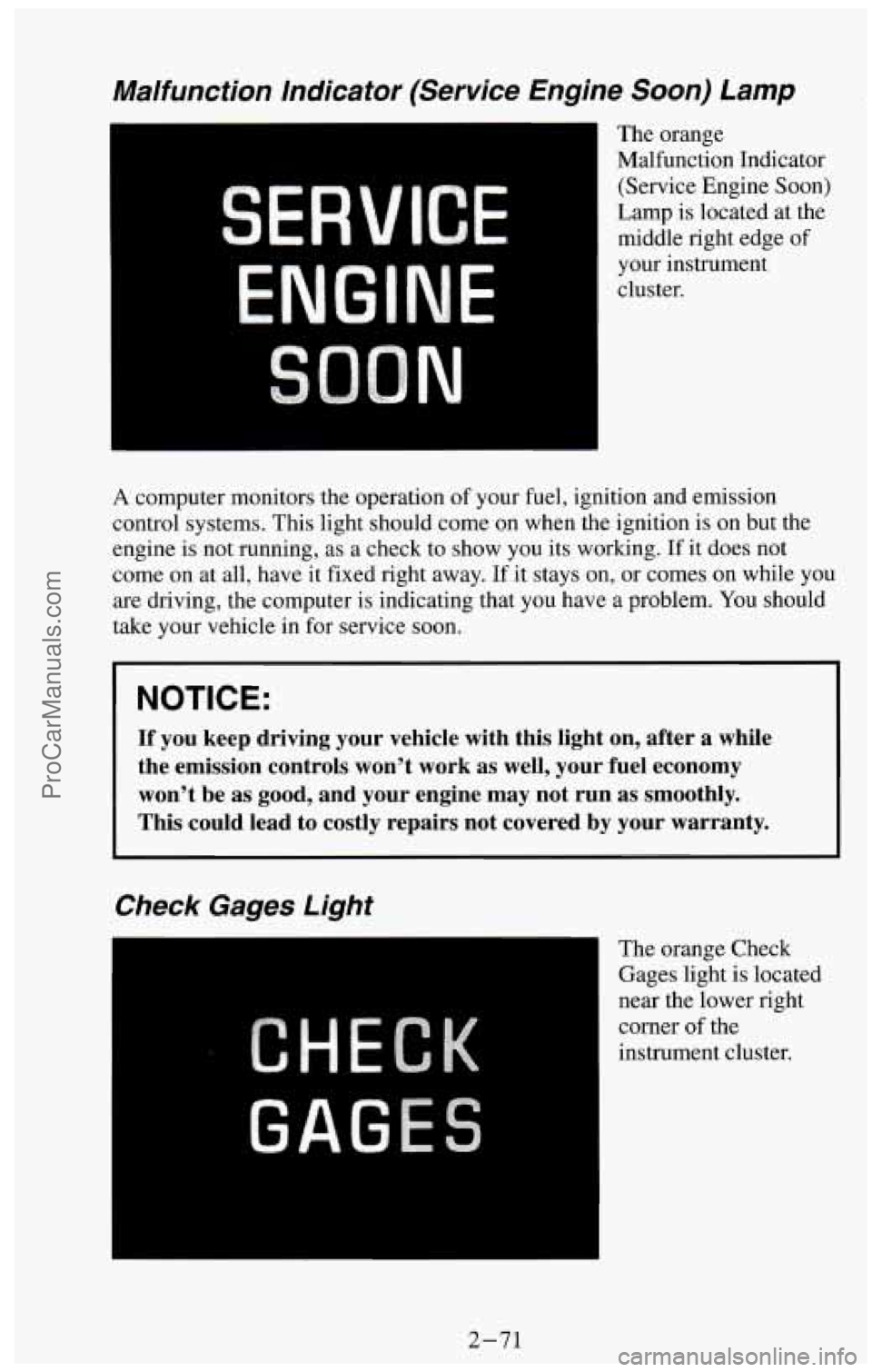
Malfunction Indicator (Service Engine Soon) Lamp
ENGINE
N
The orange
Malfunction Indicator
(Service Engine Soon)
Lamp is located at the
middle right edge of
your instrument
cluster.
A computer monitors the operation of your fuel, ignition and emission
control systems. This light should come on when the ignition is on but the
engine is not running, as a check to show you its working. If it does not
come on at all, have it fixed right away. If it stays on, or comes
on while you
are driving, the computer is indicating that you have a problem.
You should
take your vehicle in for service soon.
NOTICE:
If you keep driving your vehicle with this light on, after a while
the emission controls won’t work as well, your fuel economy \
won’t be as good, and your engine may not run as smoothly.
This could lead to costly repairs not covered by your warranty\
.
Check Gages Light
The orange Check
Gages light is located
near the lower right
corner
of the
instrument cluster.
2-71
ProCarManuals.com
Page 127 of 385
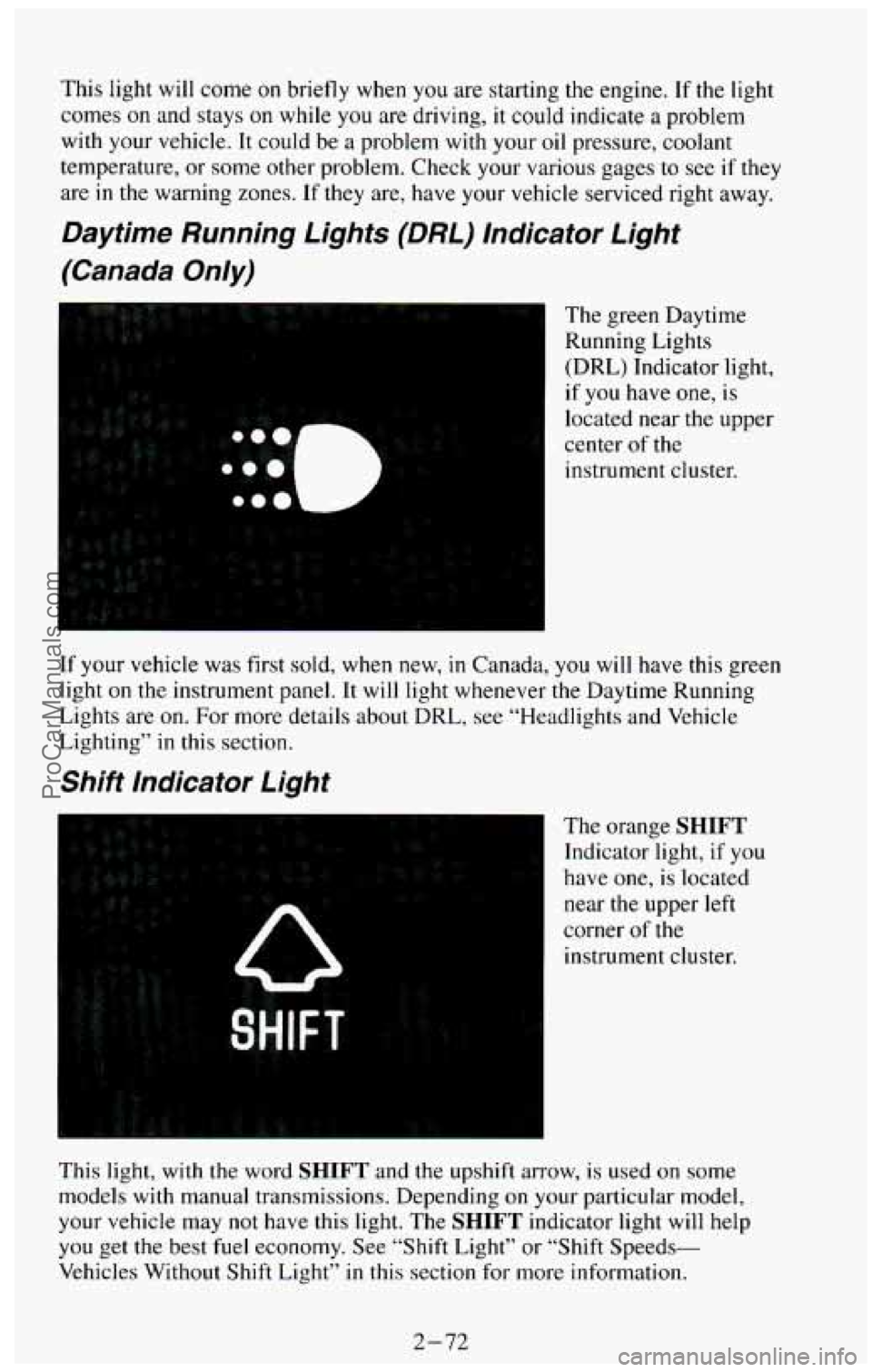
This light will come on briefly when you are starting the engine. If the light
comes
on and stays on while you are driving, it could indicate a problem
with your vehicle. It could be a problem with your oil pressure, coolant
temperature, or some other problem. Check your various gages to see
if they
are
in the warning zones. If they are, have your vehicle serviced right away.
Daytime Running Lights (DRL) Indicator Light
(Canada Only)
The green Daytime
Running Lights
(DRL) Indicator light,
if you have one,
is
located near the upper
center of the
instrument cluster.
If your vehicle was first sold, when new,
in Canada, you will have this green
light on the instrument panel. It will light whenever the Daytime Running
Lights are on.
For more details about DRL, see “Headlights and Vehicle
Lighting” in this section.
Shift Indicator Light
The orange SHIFT
Indicator light, if you
have one, is located
near the upper left
corner
of the
instrument cluster.
This light, with the word
SHIFT and the upshift arrow, is used on some
models with manual transmissions. Depending
on your particular model,
your vehicle may not have this light. The SHIFT indicator light will help
you get the best fuel economy. See “Shift Light” or “Shift Speeds-
Vehicles Without Shift Light”
in this section for more information.
2-72
ProCarManuals.com
Page 132 of 385
A reading in the low pressure zone may be caused by a dangerously low oil
level or other problem causing low oil pressure. Check your oil as soon as
possible.
I NOTICE:
Damage to your engine from neglected oil problems can be
costly and
is not covered by your warranty.
Voltmeter
Standard Cluster Tachometer Cluster
14
When your engine is not running, but the ignition is on (in the RUN
Position), this gage shows your battery’s state of charge in DC volts. When
the engine is running, the gage shows the condition
of the charging system.
Readings between the
low and high warning zones indicate the normal
operating range.
Readings
in either warning zone indicate a possible problem in the electrical
system.
2-77
ProCarManuals.com